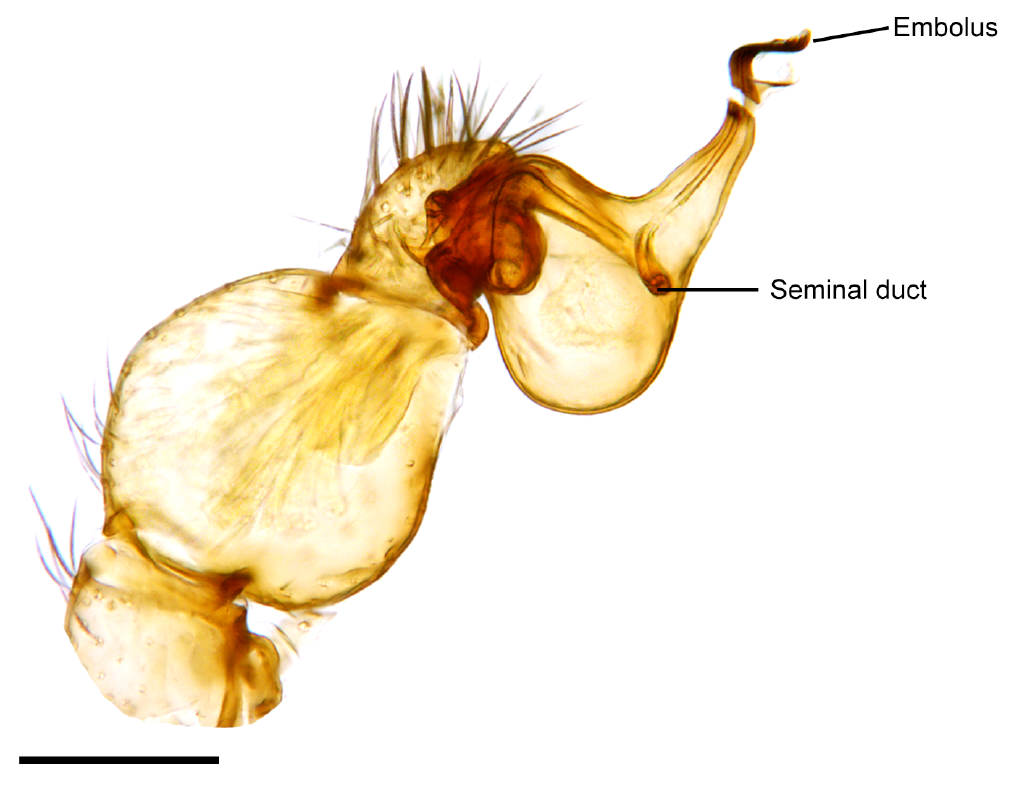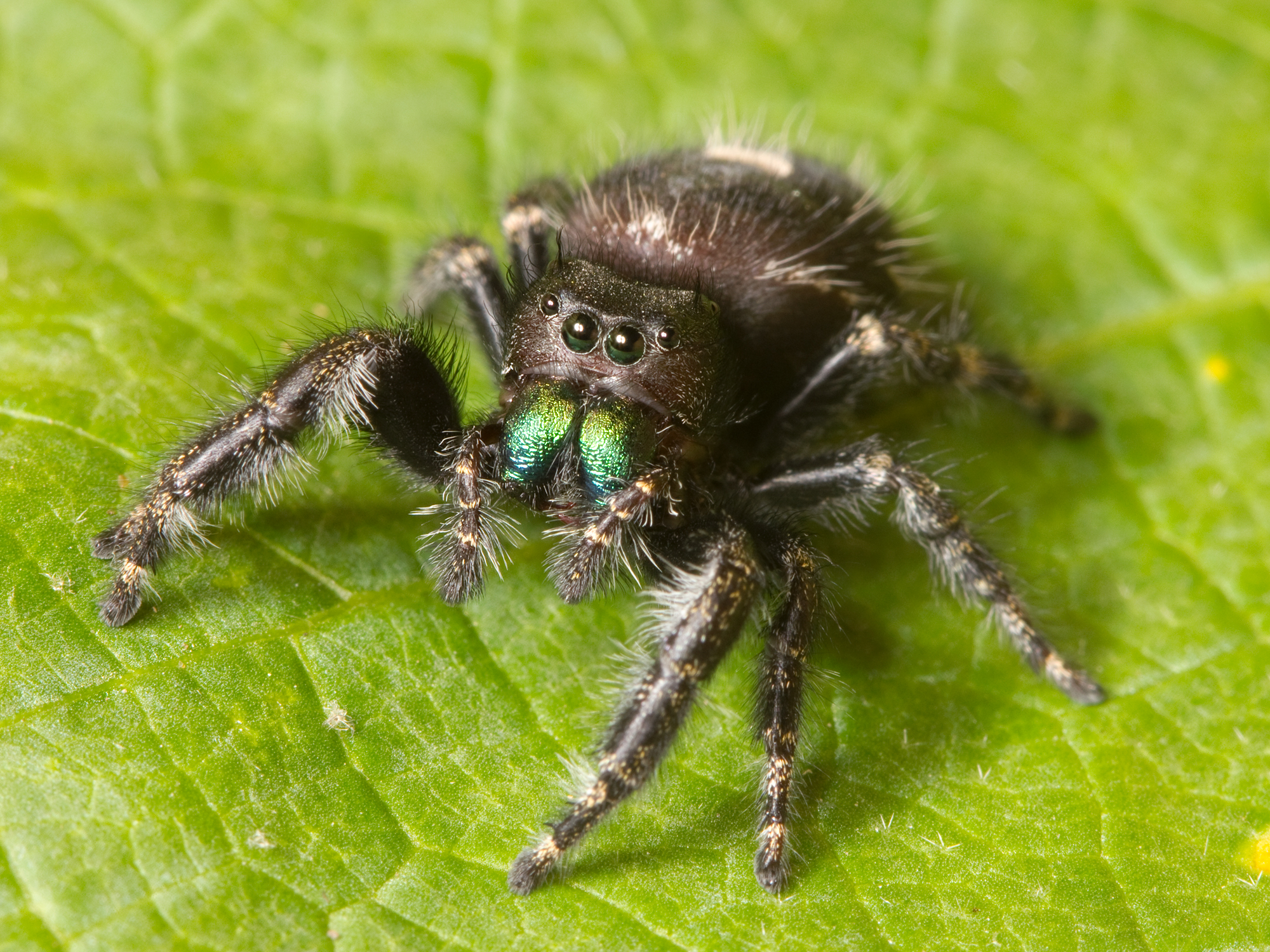|
Langelurillus Manifestus
''Langelurillus manifestus'' is a species of jumping spider in the genus ''Langelurillus'' that lives in Tanzania. It was first described in 2000 by Wanda Wesołowska and Anthony Russell-Smith. The spider is small, with a carapace that is between long and an abdomen between long. The female carapace is lighter than the male and has a pattern of irregular patches, which may also be found in some examples of the female abdomen. The male abdomen is lighter and has a fawn streak down the middle. The legs are brown, the female having dark rings on its legs. It is similar to other related species, particularly ''Langelurillus rufus'', but can be distinguished by the male's larger size and lighter coloration. The female has an oval epigyne that leads to seminal ducts that are shorter than ''Langelurillus rufus'' but longer than ''Langelurillus squamiger''. Taxonomy ''Langelurillus manifestus'' is a jumping spider that was first described by Wanda Wesołowska and Anthony Russell- ... [...More Info...] [...Related Items...] OR: [Wikipedia] [Google] [Baidu] |
Langelurillus
''Langelurillus'' is a spider genus of the family Salticidae (jumping spiders). All the described species occur only in Africa. Species , the World Spider Catalog accepted the following species: *'' Langelurillus alboguttatus'' Wesolowska & Russell-Smith, 2000 – Tanzania *'' Langelurillus cedarbergensis'' Haddad & Wesolowska, 2013 – South Africa *'' Langelurillus furcatus'' Wesolowska & Russell-Smith, 2000 – Kenya, Tanzania *'' Langelurillus holmi'' Próchniewicz, 1994 – Kenya *'' Langelurillus horrifer'' Rollard & Wesolowska, 2002 – Guinea *'' Langelurillus ignorabilis'' Wesolowska & Cumming, 2008 – Zimbabwe *'' Langelurillus kenyaensis'' Dawidowicz & Wesolowska, 2016 – Kenya *'' Langelurillus krugeri'' Wesolowska & Haddad, 2013 – South Africa *'' Langelurillus lacteus'' Sanap, Joglekar & Caleb, 2017 – India *'' Langelurillus manifestus'' Wesolowska & Russell-Smith, 2000 – Tanzania *'' Langelurillus minutus'' Wesolowska & Cumming, 2011 – Namibia, Zimbabwe ... [...More Info...] [...Related Items...] OR: [Wikipedia] [Google] [Baidu] |
Aelurillina
Aelurillina is a subtribe of jumping spiders. Nearly all species live in the Old World, except '' Phlegra hentzi''. Genera Wayne Maddison in 2015 placed the following genera in the subtribe: *''Aelurillus'' Simon, 1884 *'' Asianellus'' Logunov & Heciak, 1996 *''Langelurillus'' Próchniewicz, 1994 *'' Langona'' Simon, 1901 *''Mashonarus'' Wesołowska & Cumming, 2002 – now regarded as a synonym of ''Stenaelurillus'' *''Microheros'' Wesołowska & Cumming, 1999 – now regarded as a synonym of ''Stenaelurillus'' *'' Phanuelus'' Caleb & Mathai, 2015 *'' Phlegra'' Simon, 1876 *'' Proszynskiana'' Logunov, 1996 *''Rafalus'' Prószyński, 1999 *''Stenaelurillus ''Stenaelurillus'' is a genus of Salticidae, jumping spiders that was first described by Eugène Simon, Eugène Louis Simon in 1886. Most species live in Africa, with some species found in Asia, including China. All species have two white longitud ...'' Simon, 1886 References Salticidae {{salticidae-stub ... [...More Info...] [...Related Items...] OR: [Wikipedia] [Google] [Baidu] |
Thorax (arthropod Anatomy)
The thorax is the midsection ( tagma) of the hexapod body (insects and entognathans). It holds the head, legs, wings and abdomen. It is also called mesosoma or cephalothorax in other arthropods. It is formed by the prothorax, mesothorax and metathorax and comprises the scutellum; the cervix, a membrane that separates the head from the thorax; and the pleuron, a lateral sclerite of the thorax. In dragonflies and damselflies the mesothorax and metathorax are fused together to form the synthorax. In some insect pupae, like the mosquitoes', the head and thorax can be fused in a cephalothorax. Members of suborder Apocrita (wasps, ants and bees) in the order Hymenoptera have the first segment of the abdomen fused with the thorax, which is called the propodeum. The head is connected to the thorax by the occipital foramen, enabling a wide range of motion for the head. In most flying insects, the thorax allows for the use of asynchronous muscles Asynchronous muscles are muscl ... [...More Info...] [...Related Items...] OR: [Wikipedia] [Google] [Baidu] |
Embolus (spider Anatomy)
The two palpal bulbs – also known as palpal organs and genital bulbs – are the copulatory organs of a male spider. They are borne on the last segment of the pedipalps (the front "limbs" of a spider), giving the spider an appearance often described as like wearing boxing gloves. The palpal bulb does not actually produce sperm, being used only to transfer it to the female. Palpal bulbs are only fully developed in adult male spiders and are not completely visible until after the final moult. In the majority of species of spider, the bulbs have complex shapes and are important in identification. Structure The palpal bulb of a mature male spider is borne on the last segment of the pedipalp. This segment usually has touch-sensitive hairs (setae) with nerves leading to them. The bulb itself is entirely without nerves, and hence without sensory organs and muscles, since these depend on nerves for their functioning, although some spiders have one or two muscles external to the bulb a ... [...More Info...] [...Related Items...] OR: [Wikipedia] [Google] [Baidu] |
Pedipalp
Pedipalps (commonly shortened to palps or palpi) are the second pair of appendages of chelicerates – a group of arthropods including spiders, scorpions, horseshoe crabs, and sea spiders. The pedipalps are lateral to the chelicerae ("jaws") and anterior to the first pair of walking legs. Overview Pedipalps are composed of six segments or articles: the coxa, the trochanter, the femur, the short patella, the tibia, and the tarsus. In spiders, the coxae frequently have extensions called maxillae or gnathobases, which function as mouth parts with or without some contribution from the coxae of the anterior legs. The limbs themselves may be simple tactile organs outwardly resembling the legs, as in spiders, or chelate weapons ( pincers) of great size, as in scorpions. The pedipalps of Solifugae are covered in setae, but have not been studied in detail. Comparative studies of pedipalpal morphology may suggest that leg-like pedipalps are primitive in arachnids. At present, t ... [...More Info...] [...Related Items...] OR: [Wikipedia] [Google] [Baidu] |
Spinneret
A spinneret is a silk-spinning organ of a spider or the larva of an insect. Some adult insects also have spinnerets, such as those borne on the forelegs of Embioptera. Spinnerets are usually on the underside of a spider's opisthosoma, and are typically segmented. While most spiders have six spinnerets, some have two, four, or eight. They can move both independently and in concert. Most spinnerets are not simple structures with a single orifice producing a single thread, but complex structures of many microscopic spigots, each producing one filament. This produces the necessary orientation of the protein molecules, without which the silk would be weak and useless. Spigots can be singular or found in groups, which also permits spiders to combine multiple filaments in different ways to produce many kinds of silk for various purposes. Spinneret morphology can help arachnologists identify the taxon of a specimen and the specific morphology of a spigot can determine its use as well ... [...More Info...] [...Related Items...] OR: [Wikipedia] [Google] [Baidu] |
Labium (arthropod Mouthpart)
The mouthparts of arthropods have evolved into a number of forms, each adapted to a different style or mode of feeding. Most mouthparts represent modified, paired appendages, which in ancestral forms would have appeared more like legs than mouthparts. In general, arthropods have mouthparts for cutting, chewing, piercing, sucking, shredding, siphoning, and filtering. This article outlines the basic elements of four arthropod groups: insects, myriapods, crustaceans and chelicerates. Insects are used as the model, with the novel mouthparts of the other groups introduced in turn. Insects are not, however, the ancestral form of the other arthropods discussed here. Insects Insect mouthparts exhibit a range of forms. The earliest insects had chewing mouthparts. Specialisation includes mouthparts modified for siphoning, piercing, sucking and sponging. These modifications have evolved a number of times. For example, mosquitoes (which are flies) and aphids (which are bugs) both ... [...More Info...] [...Related Items...] OR: [Wikipedia] [Google] [Baidu] |
Chelicerae
The chelicerae () are the mouthparts of the subphylum Chelicerata, an arthropod group that includes arachnids, horseshoe crabs, and sea spiders. Commonly referred to as " jaws", chelicerae may be shaped as either articulated fangs, or similarly to pincers. Some chelicerae, such as those found on nearly all spiders, are hollow and contain (or are connected to) venom glands, and are used to inject venom into prey or a perceived threat. In '' Pisaurina mira'', also known as the nursery web spider, the chelicerae are utilized to snatch the prey once it becomes within reach, facilitating the "sit-and-wait ambush predator" behavior. Both pseudoscorpions and harvestmen have structures on their chelicerae that are used for grooming (papillae in pseudoscorpions, cheliceral teeth in Opiliones). Types Chelicerae can be divided into three kinds: jackknife chelicerae, scissor chelicerae, and 3-segmented chelate chelicerae. Jackknife chelicerae The jackknife chelicera is subchelate ... [...More Info...] [...Related Items...] OR: [Wikipedia] [Google] [Baidu] |
Clypeus (arthropod Anatomy)
The clypeus is one of the sclerites that make up the face of an arthropod. In insects, the clypeus delimits the lower margin of the face, with the labrum articulated along the ventral margin of the clypeus. The mandibles bracket the labrum, but do not touch the clypeus. The dorsal margin of the clypeus is below the antennal sockets. The clypeus is often well-defined by sulci ("grooves") along its lateral and dorsal margins, and is most commonly rectangular or trapezoidal in overall shape. The post-clypeus is a large nose-like structure that lies between the eyes and makes up much of the front of the head in cicadas. In spiders, the clypeus is generally the area between the anterior edge of the carapace A carapace is a dorsal (upper) section of the exoskeleton or shell in a number of animal groups, including arthropods, such as crustaceans and arachnids, as well as vertebrates, such as turtles and tortoises. In turtles and tortoises, the und ... and the anterior eyes. R ... [...More Info...] [...Related Items...] OR: [Wikipedia] [Google] [Baidu] |
Spider Vision
The eyes of spiders vary significantly in their structure, arrangement, and function. They usually have eight, each being a simple eye with a single lens (optics), lens rather than multiple units as in the compound eyes of insects. The specific arrangement and structure of the eyes is one of the features used in the identification and classification of different species, genera, and families. Most Haplogynae, haplogynes have six eyes, although some have eight (Plectreuridae), four (e.g., ''Tetrablemma'') or even two (most Caponiidae). In some cave species, there are no eyes at all (e.g. Stalita taenaria). Sometimes one pair of eyes is better developed than the rest. Several families of hunting spiders, such as jumping spiders and wolf spiders, have fair to excellent vision. The main pair of eyes in jumping spiders even sees in colour. Structure and anatomy Spiders' eyes are Simple eye in invertebrates, simple eyes, or ''ocelli'' (singular ''ocellus''), meaning their eyes have a si ... [...More Info...] [...Related Items...] OR: [Wikipedia] [Google] [Baidu] |
Latin
Latin (, or , ) is a classical language belonging to the Italic branch of the Indo-European languages. Latin was originally a dialect spoken in the lower Tiber area (then known as Latium) around present-day Rome, but through the power of the Roman Republic it became the dominant language in the Italian region and subsequently throughout the Roman Empire. Even after the fall of Western Rome, Latin remained the common language of international communication, science, scholarship and academia in Europe until well into the 18th century, when other regional vernaculars (including its own descendants, the Romance languages) supplanted it in common academic and political usage, and it eventually became a dead language in the modern linguistic definition. Latin is a highly inflected language, with three distinct genders (masculine, feminine, and neuter), six or seven noun cases (nominative, accusative, genitive, dative, ablative, and vocative), five declensions, four ... [...More Info...] [...Related Items...] OR: [Wikipedia] [Google] [Baidu] |







